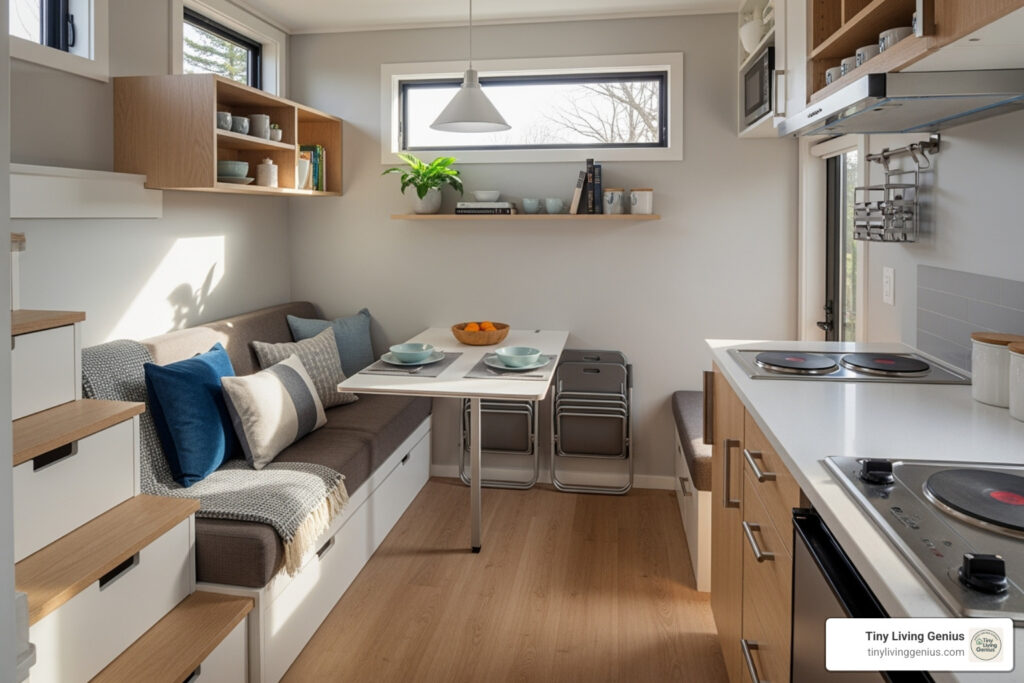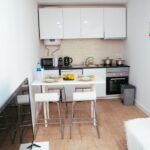Tiny Home Furniture: 7 Amazing Resources
Why Tiny Home Furniture Matters More Than Ever
Tiny home furniture is the key to changing cramped quarters into comfortable, functional living spaces. Here’s what you need to know:
Key Furniture Types for Tiny Homes:
- Multi-functional pieces – Sofa beds, lift-top coffee tables, storage ottomans
- Wall-mounted solutions – Floating desks, fold-down tables, vertical shelving
- Modular & foldable items – Nesting tables, folding chairs, expandable dining tables
- Space-saving designs – Murphy beds, trundle beds, corner TV stands
The tiny house market is exploding—projected to grow from $4.5 billion in 2021 to $7.5 billion by 2027. But here’s the challenge: 75% of tiny house dwellers report that their furniture must serve multiple purposes, and the average tiny home is just 100-400 square feet.
That’s a lot of living to pack into very little space.
The difference between a cramped box and a cozy sanctuary comes down to furniture choices. Every piece needs to earn its place by maximizing function, creating storage opportunities, and maintaining an open, breathable feel. A sofa that converts to a bed, a coffee table that lifts to become a desk, or a dining table that folds flat against the wall—these aren’t luxuries in tiny living. They’re necessities.
The biggest mistake? Buying traditional furniture and hoping it fits. It won’t. Tiny homes demand intentional design, vertical thinking, and clever storage solutions hidden in plain sight.
I’m Ramy Saber, founder of Tiny Living Genius, and I’ve spent years helping people maximize small spaces through smart tiny home furniture selections and layout strategies. This guide compiles the best resources I’ve finded to help you furnish your compact space with confidence.
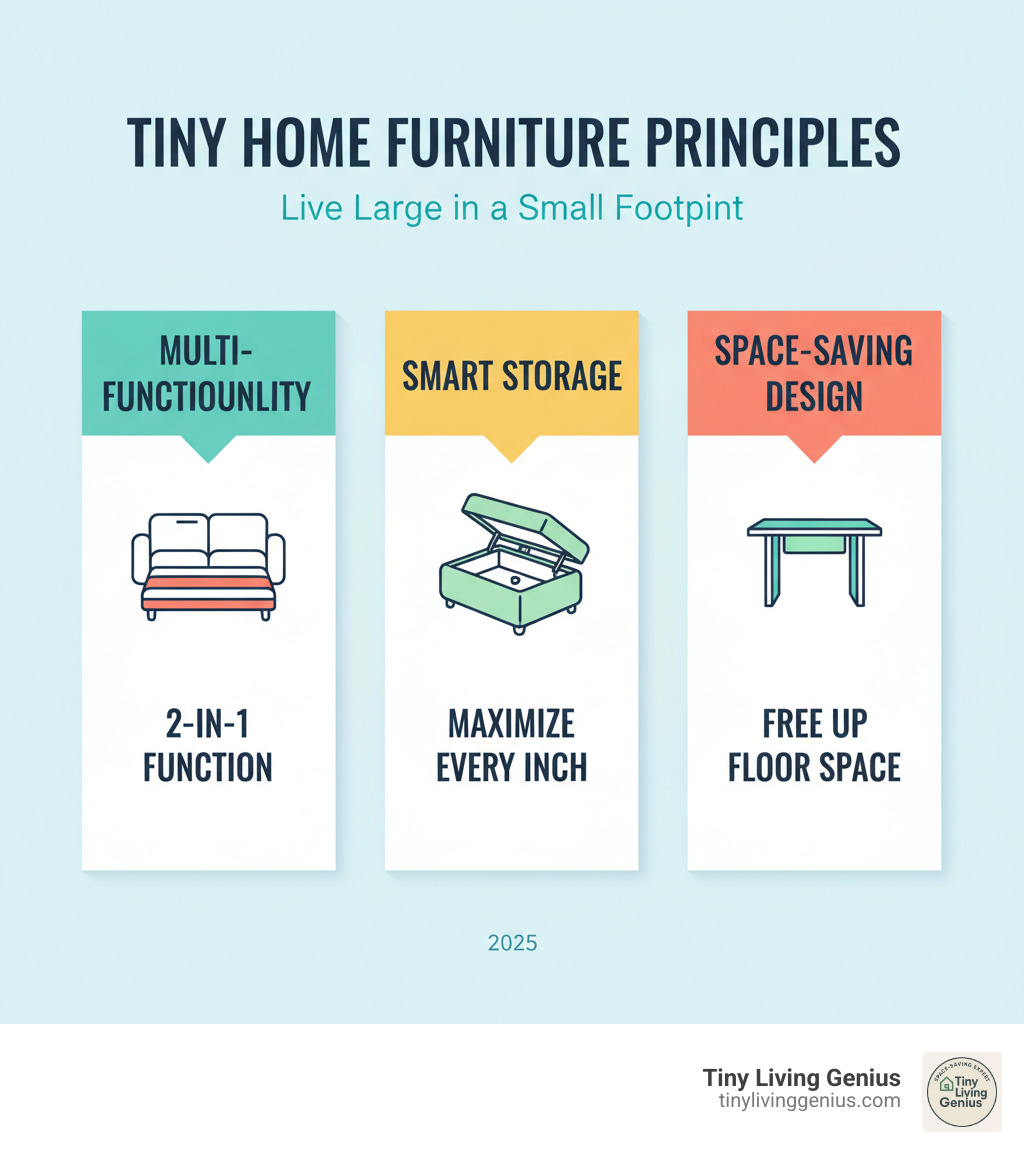
The “What”: Essential Types of Space-Saving Furniture
Before shopping, you must understand the essential categories of tiny home furniture. The challenge isn’t just finding pieces that fit, but ones that work overtime to maximize every square foot while keeping your space feeling open and inviting.
Multi-Functional Marvels
Multi-functional furniture is the backbone of any successful tiny home. A sofa bed or futon solves sitting and sleeping needs without a separate guest room. A lift-top coffee table rises to desk height and hides storage for laptops or remotes. Expandable dining tables fold to a slim console, then expand for hosting. Ottomans with hidden storage provide seating, a footrest, and a place for blankets or games. Each piece must justify its existence by doing more than one job, creating a home that adapts to your life throughout the day.
Creative Ideas for Small Space Furniture: Maximizing Functionality
Vertical & Wall-Mounted Wonders
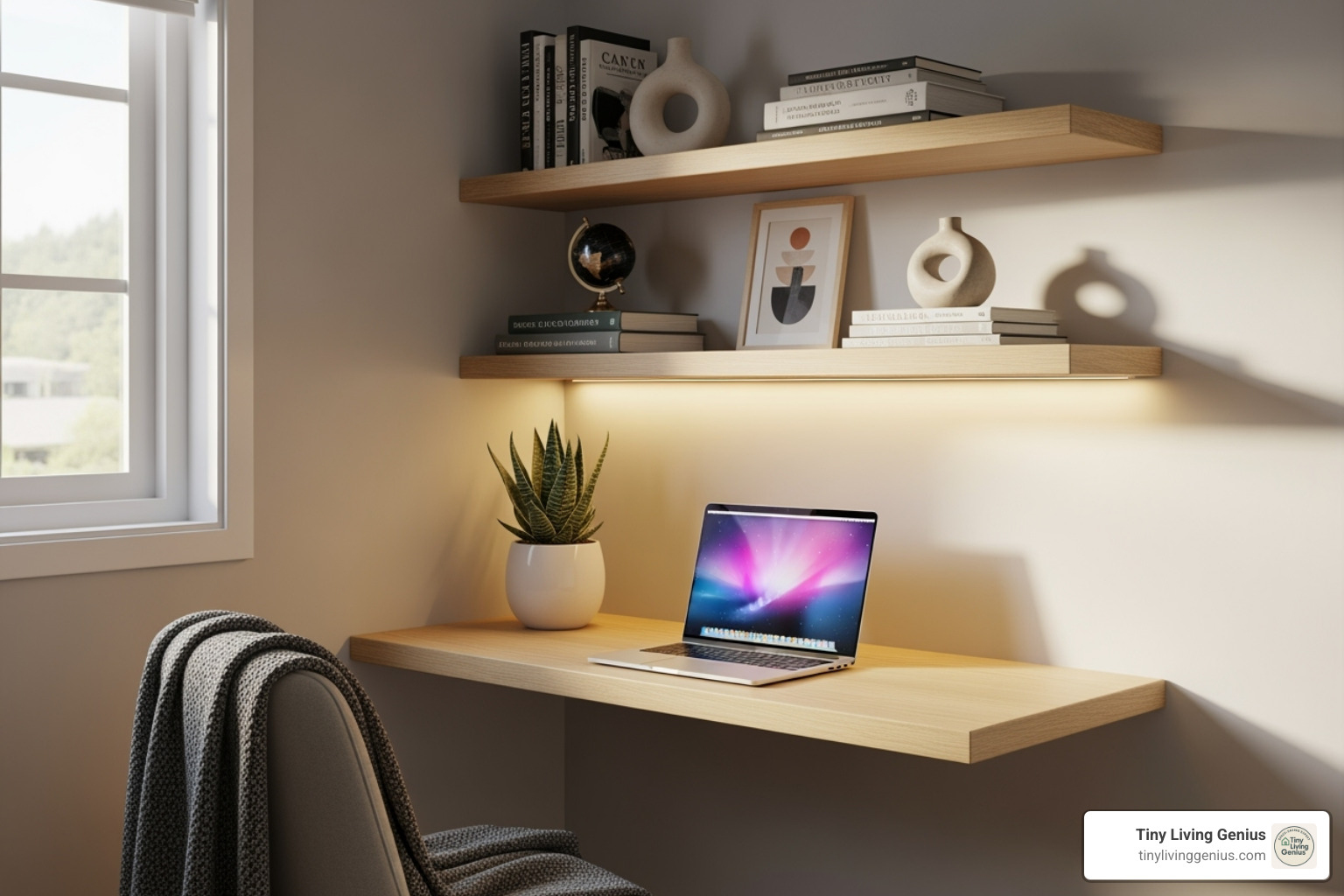
When floor space is precious, look up. Vertical and wall-mounted furniture turns walls into functional storage and workspace. Floating shelves display decor without using floor space. Wall-mounted desks and fold-down tables create a workspace or dining area, then disappear flat against the wall. In the kitchen, hanging pot racks free up cabinet space. Getting furniture off the floor makes a tiny home feel less cluttered and more breathable. Seeing more of the floor creates an optical illusion, making the space feel bigger than it is.
Maximize Vertical Space in Small Spaces
Modular & Foldable Furniture
Flexibility is key in a tiny home that needs to morph throughout the day. Modular and foldable furniture is the solution. Modular sofas are built from sections you can rearrange to fit your space, with many hiding storage or converting to beds. Nesting tables stack together, pulling out to create multiple surfaces when needed. Folding chairs and stools can hang on a wall or hide in a closet. Drop-leaf tables have hinged sections that fold down to shrink their footprint. This adaptability creates a home that bends to your needs, making tiny living feel spacious.
10 Foldable Furniture Ideas for Small Apartments
The “Where”: 7 Amazing Resources for Tiny Home Furniture
Finding the perfect tiny home furniture can feel like a treasure hunt, but with the right resources, it becomes an exciting adventure. Here are our top picks for where to find furniture that fits your tiny lifestyle and budget.
1. Tiny Living Genius Curated Collections
We live and breathe small space solutions. Our team curates collections of space-saving and multi-functional furniture, handpicked for ingenuity and style in compact environments. From storage beds to convertible tables, these collections take the guesswork out of furnishing your tiny home. We’ve done the research to ensure every item maximizes both function and aesthetic appeal.
30 Products & Furniture For Small Spaces
2. Tiny Living Genius Online Shop
Our online shop is a dynamic marketplace for innovative and compact furniture. We continuously seek out the best new designs and classics suited for tiny homes. The shop features a diverse range of tiny home furniture, from modular seating to clever storage units, all selected for durability, smart design, and the ability to improve your living experience. It’s your go-to source for that perfect, unexpected find.
Tiny Home Furniture Collection
3. Custom Solutions & Local Craftsmanship
Sometimes, off-the-shelf solutions just won’t cut it, especially when dealing with the unique dimensions and quirky nooks of a tiny home. This is where custom-built furniture and local craftsmanship shine, providing innovative designs specifically custom for tiny living. Custom pieces ensure a perfect fit, maximizing every single inch—even those awkward spaces that would otherwise go unused.
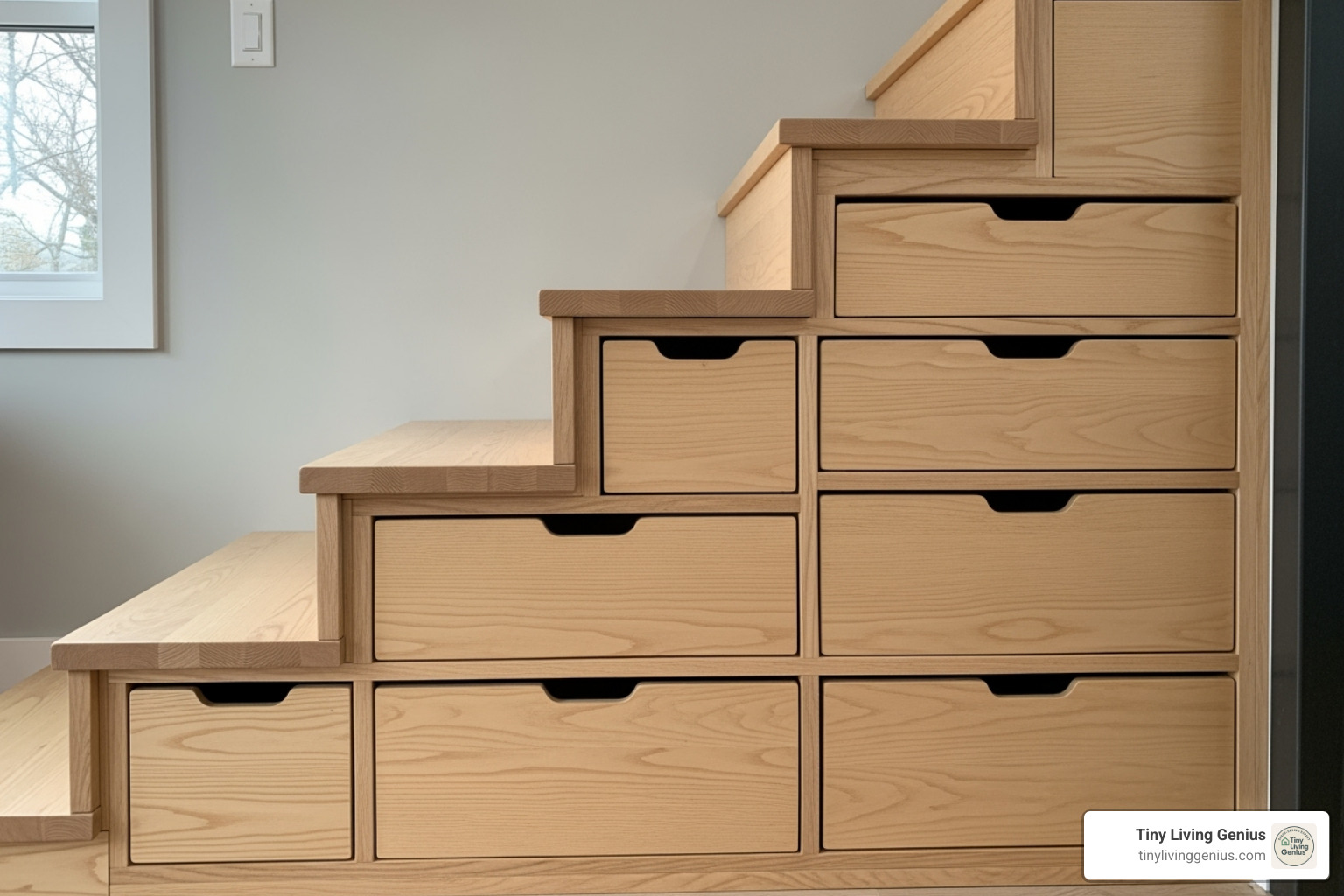
Imagine built-in storage like under-stair drawers that swallow up clothes or kitchenware, or a custom-designed window seat that doubles as a storage chest. We’ve seen incredible examples, like users carefully planning their 200 sq ft studios with graph paper and furniture cutouts to adapt pieces around architectural features like wheel wells. Whether it’s a triangular folding desk that fits perfectly into a corner or a bookcase with a custom cutout for a structural beam, local craftspeople can bring these visions to life. Tiny Living Genius also offers resources and insights into finding these talented artisans, helping you transform challenges into unique design opportunities. Custom tiny home furniture is an investment that pays dividends in functionality and personalized style.
4. Second-Hand & Upcycling Ideas
Furnishing a tiny home doesn’t have to break the bank, nor does it have to contribute to landfill waste. Second-hand and upcycling options offer a sustainable and budget-friendly approach to finding unique tiny home furniture. This resource is particularly valuable for those on a budget or looking for pieces with character.
Thrift stores, Habitat Restore, and local online marketplaces or social media groups (like Facebook’s “Free” groups) are fantastic places to start your hunt. You might find a vintage piece that, with a little love and creativity, can be perfectly adapted for your tiny space. “40 grit sandpaper exists for a reason,” as one tiny house dweller wisely put it – meaning you shouldn’t be afraid to modify or customize a thrifted find to suit your needs. Upcycling allows you to repurpose existing items, giving them new life and a new function. A sturdy old chest could become a coffee table with hidden storage, or a vintage locker could transform into a slim pantry. Not only is this approach environmentally friendly, but it also allows you to infuse your tiny home with unique, one-of-a-kind pieces that tell a story.
5. Design & Inspiration from Tiny Living Genius
Sometimes the best resource is pure inspiration. Our platforms are brimming with creative ideas and real-life examples of tiny home interiors. We update our Pinterest boards with innovative layouts and storage hacks, while our Instagram offers daily inspiration featuring smart tiny home furniture in action. Our design blog articles dig deeper into topics like color palettes and lighting, showing how furniture choices impact spaciousness. Following our channels ensures you’ll never be short of fresh ideas for your tiny home.
Follow Tiny Living Genius on Instagram for daily inspiration
6. DIY Plans & Community Projects
For the hands-on tiny homeowner, DIY plans and community projects are an invaluable resource. Building your own tiny home furniture offers the ultimate in customization and can lead to significant cost savings. Whether you’re adapting an existing piece or constructing something from scratch, the satisfaction of creating furniture perfectly suited to your space is immense.
Tiny Living Genius provides access to DIY furniture plans, step-by-step guides, and a vibrant community forum where you can share ideas, ask questions, and learn from fellow tiny house enthusiasts. We’ve seen incredible creativity, from custom-built triangular folding desks that slot into corners to bespoke shelving units designed to maximize vertical storage. This approach allows you to tailor every dimension, material, and finish to your exact needs, ensuring that your furniture integrates seamlessly with your home’s unique architecture. It’s an empowering way to furnish your space, turning a simple piece of wood into a multi-functional marvel or a clever storage solution.
7. Tiny Living Genius Marketplace Picks
For those who prefer a curated shopping experience without the DIY effort, our Tiny Living Genius Marketplace Picks are a fantastic resource. We comb through countless products from various retailers to bring you a handpicked selection of top-rated, space-saving finds. These aren’t just random items; they are rigorously reviewed by our team and often by real users, ensuring they meet the practical and aesthetic demands of tiny living.
Our picks include everything from narrow console tables that serve as entryways in tight spaces, to versatile storage ottomans that provide both seating and hidden compartments, and foldable desks that disappear when not needed. We focus on items that demonstrate exceptional design, durability, and multi-functionality. This resource simplifies your search, presenting you with reliable, high-quality tiny home furniture solutions that have proven their worth in real-world tiny homes.
The “How”: Design Principles for a Spacious Feel
Finding the furniture is half the battle; knowing how to integrate it is the key to success. I’ve learned that simply cramming the right pieces into a tiny home won’t magically create a comfortable sanctuary. The real magic happens when you understand how to arrange, style, and present your tiny home furniture to maximize both function and flow.
Key Principles for Selecting Your Tiny Home Furniture
When you’re choosing tiny home furniture, size isn’t the only consideration. I’ve seen plenty of “apartment-sized” sofas that still feel overwhelming because they’re too deep or have chunky, bulky arms that eat up visual space. What we really want to focus on is scale and proportion—how a piece relates to the room around it.
One of my favorite tricks is selecting “leggy” furniture. These are pieces with exposed legs, like you’d find in mid-century modern designs. It might seem like a small detail, but showing more floor creates an incredible illusion of openness. When you can see the floor extending under a sofa or chair, your brain interprets the room as larger and airier.
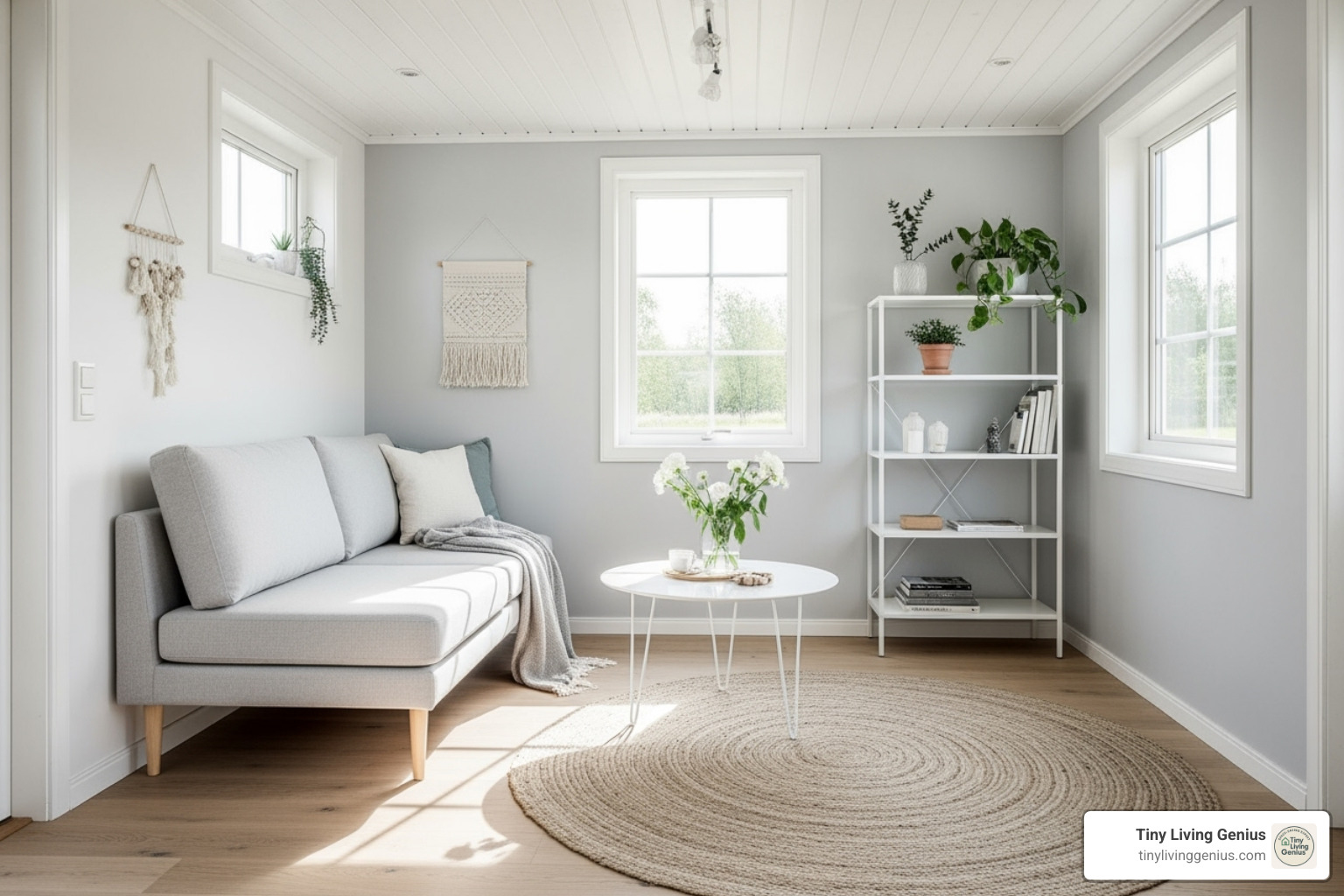
Another game-changer is using clear acrylic or glass pieces. A glass coffee table provides a perfectly functional surface without visually breaking up your space. It’s almost like it’s not there—in the best way possible. Your eye can travel right through it, which reduces the feeling of clutter and keeps the room feeling open.
Lightweight materials are also your friend. Not only are they easier to move around (especially important if you have a tiny home on wheels), but they tend to look less imposing. The goal with every furniture choice is to maintain that precious sense of spaciousness, even when every square foot is spoken for.
Choosing Furniture for Small Spaces Effectively
Using Color, Light, and Layout
Here’s a truth I’ve learned from years of working with small spaces: the furniture itself is only part of the equation. The way you use color, light, and layout can completely transform how spacious your tiny home feels.
Let’s start with color. A neutral color palette for walls and larger furniture pieces isn’t boring—it’s brilliant. Whites, grays, and soft beiges reflect light beautifully, making rooms feel airier and more expansive. These colors create a calm, cohesive backdrop that prevents your space from feeling visually chaotic. Once you have that neutral foundation, you can add personality through strategic pops of color—a vibrant throw pillow here, a piece of colorful artwork there, or a lush plant in the corner.
Natural light is absolutely king in tiny living. Whether you’re working with 150 square feet or 400, maximizing natural light should be a top priority. This means positioning your furniture so it doesn’t block windows. I know it’s tempting to push that sofa against the window wall, but if it means sacrificing precious daylight, it’s not worth it. Choose furniture finishes that bounce light around the room rather than absorbing it.
Mirrors are another secret weapon in the tiny home arsenal. A well-placed mirror can create depth, amplify natural light, and make a space feel twice its actual size. I’ve seen tiny bathrooms and hallways completely transformed by a single strategically positioned mirror.
Finally, think carefully about your layout. A clear pathway for flow is essential—you shouldn’t have to do a gymnastics routine just to get from your bed to your kitchen. Arrange furniture to allow easy movement between different zones. Sometimes this means embracing unconventional layouts and skipping traditional design rules. If a standard kitchen island or a pair of nightstands would block your flow or steal precious light, don’t use them. Every layout decision should contribute to an open, functional environment that feels good to live in.
Tips on Using a Tight Color Palette
Common Mistakes to Avoid When Buying Tiny Home Furniture
I’ve seen every mistake in the book when it comes to furnishing tiny homes, and I want to help you avoid the most common pitfalls. These errors can turn a potentially cozy space into a cramped, frustrating living situation.
The biggest blunder? Buying oversized furniture. Just because you fell in love with that sprawling sectional at the furniture store doesn’t mean it belongs in your 200-square-foot living room. Bulky pieces will instantly overwhelm your space, making it feel cramped and difficult to steer. Similarly, choosing dark, bulky pieces can absorb light and make your room feel smaller and more cave-like. We’re going for light and airy, not dungeon chic.
Blocking natural light or walkways is another frequent mistake. Every window in a tiny home is precious real estate for daylight. Don’t obscure it with a towering bookshelf or position your sofa so it cuts off that beautiful morning sun. Always ensure there’s a clear path for movement through your space—your tiny home shouldn’t feel like an obstacle course.
Here’s one that makes me cringe every time: ignoring vertical space. We often get so focused on the floor plan that we completely forget about our walls. Failing to use floating shelves, wall-mounted cabinets, or tall, slender storage units means you’re leaving valuable real estate completely untapped.
Finally, prioritizing form over function is a classic tiny home mistake. That gorgeous chair might look incredible in the showroom, but if it doesn’t offer storage, fold up, or convert into something else, is it really the best choice for your compact lifestyle? Every piece of tiny home furniture should earn its keep by serving multiple purposes. And please, always measure your space accurately before purchasing anything. I can’t tell you how many times I’ve heard stories of people buying furniture that simply won’t fit through the door or overwhelms the room once it’s inside.
Frequently Asked Questions about Tiny Home Furniture
How do you maximize storage with furniture in a tiny home?
Storage is the eternal quest in tiny living, and your furniture can be your greatest ally. The secret is to prioritize pieces that work double duty, hiding storage in plain sight. With 80% of tiny house residents making built-in storage a top priority, it’s clear this isn’t just a nice-to-have—it’s essential.
Start with the obvious champions: storage ottomans that serve as comfy footrests while secretly stashing blankets, books, or games inside. Beds with drawers are absolute game-changers, turning the typically wasted space under your mattress into a home for clothing, linens, or seasonal items. Platform beds with deep, pull-out storage are particularly brilliant for this. Your coffee table shouldn’t just hold your morning brew—look for ones with hidden compartments or lift-top designs that can tuck away remote controls, magazines, or even your laptop when you’re done working.
But here’s where many people stop thinking, and that’s a mistake. Think vertically. Your walls are valuable real estate just waiting to be used. Tall, narrow shelving units draw the eye upward, creating a sense of height while maximizing every available inch. Wall-mounted cabinets, especially in kitchens and bathrooms, keep essentials organized without eating into your floor space. Even seemingly awkward spots—above your toilet, under your stairs, or in that odd corner—can be transformed with custom shelving or drawers. Every surface from floor to ceiling should be considered a potential storage opportunity.
What furniture makes a tiny home look bigger?
The right tiny home furniture doesn’t just fit in your space—it actively makes it feel larger and more breathable. It’s all about creating visual tricks that fool the eye into seeing more space than actually exists.
First, accept what we call “leggy” furniture—pieces with exposed legs that show more of your floor. Mid-century modern styles excel at this. When you can see the floor beneath a sofa or chair, the room automatically feels more open and less cluttered. It’s a simple design choice that makes a surprisingly big difference.
Next, consider clear materials like glass or acrylic. A glass coffee table provides a functional surface without creating a visual barrier, allowing light to pass through and maintaining that crucial sense of openness. Clear dining chairs work the same magic—they’re there when you need them, but they don’t add visual weight to the room.
Light colors are your friend. Furniture in whites, grays, or beiges reflects light beautifully, making rooms feel brighter and airier. This doesn’t mean your space has to be boring—you can still add personality with colorful accents—but your larger pieces should help bounce light around rather than absorb it.
Finally, wall-mounted furniture like floating desks or shelves frees up floor space, which directly translates to a sense of greater openness. The more floor you can see, the bigger your tiny home will feel.
Can you use regular furniture in a tiny house?
Yes, but you need to be strategic about it. Not all regular furniture will work, but with careful selection, you can absolutely find standard pieces that fit beautifully in your tiny home.
The key is focusing on “apartment-sized” or smaller-scale pieces rather than the oversized, sprawling furniture designed for traditional homes. Before you buy anything—and we mean anything—measure your space carefully. Get those dimensions down to the last inch, including doorways and any tight corners you’ll need to steer. Then measure the furniture you’re considering, paying close attention to depth, width, and height.
Avoid anything overly bulky, ornate, or with excessive ornamentation. These pieces will quickly overwhelm a small room, making it feel cramped and difficult to move through. Instead, prioritize functionality. If a “regular” piece of furniture also offers storage, folds away, or serves dual purposes, it might be perfect. A slim console table could work wonderfully as an entryway piece. A compact dining table with drop-leaves might be ideal for everyday use and entertaining.
The bottom line? Regular furniture can absolutely work in a tiny home—you just need to be more selective and intentional than you would in a larger space. Every piece should earn its place by enhancing your living experience rather than making your compact home feel even smaller.
Conclusion
Furnishing a tiny home is a creative journey of making smart, intentional choices. It’s about designing a space that functions flawlessly and reflects your personality, even within 100-400 square feet.
The beauty of tiny home furniture is its ability to transform constraints into opportunities. By embracing multi-functional pieces, utilizing vertical space, and choosing adaptable modular or foldable designs, you can make any compact footprint feel spacious and personal.
This guide has provided the what, where, and how for finding these gems and integrating them harmoniously. At Tiny Living Genius, we believe living small means living smarter, not sacrificing style or comfort. Your tiny home should be a sanctuary that brings you joy.
We hope these resources and principles empower you to create the tiny home of your dreams. Every square inch is valuable—treat it that way, and you’ll be amazed at what’s possible.
Explore our complete guide to Space-Saving Furniture for more ideas!

